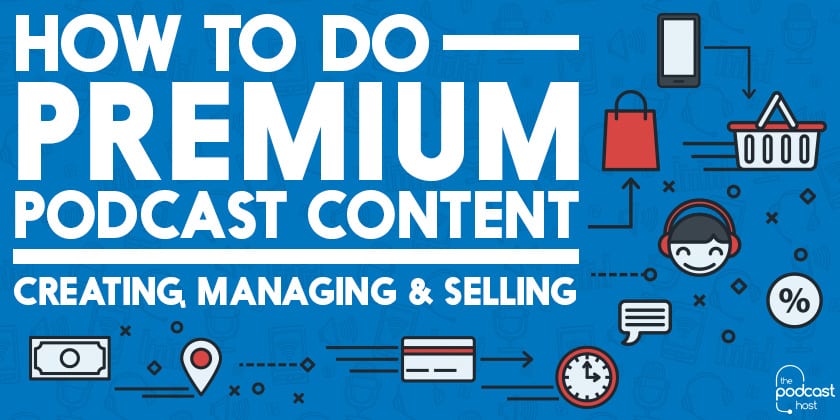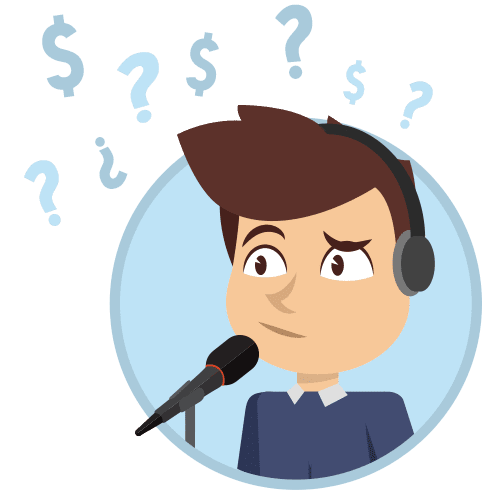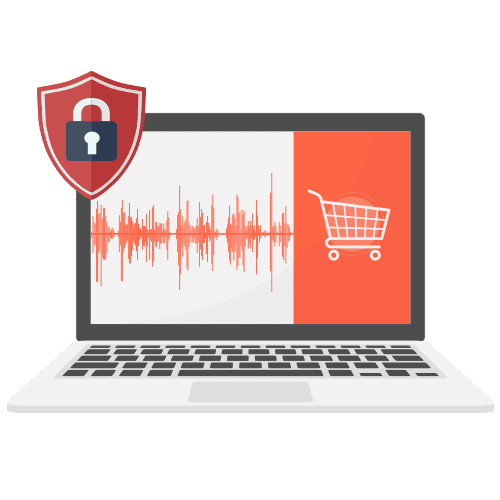How to do Premium Podcast Content: Creating, Managing & Selling

When it comes to making money through your podcast, as with a lot of things in life, the simpler the better. Both for you and your audience. After all, if you waste a huge amount of time managing the show rather than creating great content, then that’s no good for either.
In this article I’m going to look at one of the most simple, obvious ways to monetise a podcast: by creating more of the same, but, this time, charging for it.
This is the world of premium podcast content.
I’ll explain what premium content is, and how to create it. Then we’ll dig into why, with the right tools, it’s one of the most simple and effective monetisation methods out there.
Don’t worry, I wont leave you hanging – we’ll go into what those tools are, too. The options are many, from the free-but-time-intensive method, to the paid but slick-as-ice.
In the end, I’ll show you how our favourite premium tool, from long-time hosting company, Podbean, helps you create a brilliant set-and-forget-it system to allow your listeners to buy and listen to your premium content.
Ok, ready to start making a bit of cash from your show? Let’s take a look.
Why Should I Do Premium Content?
Why’s it a simple method? Because you’re doing it already! You already create a show, and you enjoy it. The kit, the skills and the process are in place. You already have an audience for it too, in the form of your loyal subscribers. And, it’s a way of monetising that feels like you’re adding value, giving more great stuff.
Compare this to sponsorship, where there are two big downsides. Firstly, you need to learn a bunch of new skills. Sales and logistics are two of the biggest – finding sponsors, selling them, managing contracts, and then delivering the slots and results on a regular basis.
Secondly, and more importantly, it’s a method that feels like it’s removing value from the show. It’s possible to create good quality ads about engaging products, but they’re almost always a segment that your listener would skip if they can.
There are other ways, of course, like selling a related product or service, but premium content is definitely an easy way to start, and one that’s worked well for many. Let’s take a look at how it works.
What is Premium Content?

Premium content, in the podcasting world, is an extra episode that isn’t available on your normal podcast feed.
As you know, Podcasting is generally considered a free-of-charge medium. You jump on Apple Podcasts or Pocket Casts and subscribe to any one of thousands of shows, all for free. We’re used to that, and that’s how you build your own squad of fanatical fans.
But, once you have that squad – those people that love what you do – then they’re often clamouring for more of the same. If you’re a weekly show, then once a week might not be enough for them!
That’s where premium content comes in. For example, on Podcraft I might say:
“I’m going to start recording a bonus episode, every week, where I dive deeper into that weekly topic. For example, say I do a show on Facebook ads to grow your audience. Once I’ve finished the main, free episode, I’ll then do an interview with a top podcaster, showing exactly how they’ve put Facebook ads into action to grow their audience. And those episodes, my wonderful listener, are going to be available for a mere $5 per month. Help support the free content we do, and get our bonus episodes, by signing up at Podcraft.net/bonus!”
Now, I don’t do that (yet…), so don’t visit that link! But, that’s how it works. Listeners can pay specifically to receive the bonus episodes, every week. And, you’ll often find that loyal fans might subscribe simply to support your free content. The extra episodes are just an added bonus!
How Can I Deliver it?
There are a whole range of ways to manage payments and delivery, so here’s where we get the best approaches. As usual, they range from free-but-hard-work, to costly-but-easy. Let’s run through them.
Manual Premium Content

The least complex way (but not necessarily the simplest…) is to run the system entirely manually. This is totally free, as well, apart from payment fees, and might suit those just starting out with quite small audiences.
Password Protecting a Podcast Feed Manually
To do this, simply set up a new RSS feed and password protect it. It’s really easy with a podcasting plugin like BluBrry Powerpress or Seriously Simple Podcasting.
Powerpress lets you set up as many new podcast feeds as you want, and to password protect any or all of them. So, you can have your normal free-of-charge feed running, as normal, and one or more password protected feeds running alongside. Anyone with the password can subscribe to that protected feed, and enter the password when requested.
Taking Payments
All you need, now, is a way of taking payment. That can be as simple as Paypal. They offer really easy recurring payment buttons. Although, I’ll admit they don’t offer as simple a dashboard for managing them…
Or, you might use Patreon. You could set up a Patreon campaign where people at a certain contribution level get access to the premium content.
The ‘manual’ part of this is that the payments methods – Patreon and Paypal – have no link, whatsoever, to your podcast feed. That means you have to send the password to paying subscribers manually. It’ll be a weekly or a monthly task for you to keep that up to date.
And, of course, with just one general password on your feed, you’ll need to change it on a monthly basis to make sure only ‘current’ subscribers get it. That’s a time consuming process when your list gets big, and it’s the big problem that automated systems, like Podbean’s Patron service, solves. But we’ll talk about that later!
Powerpress does let you link premium podcast access to WordPress user accounts, so it’s possible to automate elements of this for free. Even then, you still need to match up paying subscribers and active accounts on a regular basis.
Downsides, indeed, but, hey, it’s pretty simple to set up, at least. And it only costs the Paypal/Patreon fees.
 Protected Site
Protected Site
Next, we have the membership site model. This is when you set up a ‘protected area’ of your normal website and members have to pay for access to it.
Our very own Podcast Host Academy is a perfect example of this. The customer pays a monthly membership fee to register their own account and, through that, they have access to the membership content for as long as the subscription stays active.
What Membership Plugin?
There as millions of membership plugins out there (slight exaggeration, but it seems that way…) that can do this. We use Woocommerce Subscriptions and Memberships. Memberpress is another really popular one. These systems automatically create subscriptions, handle monthly payments and manage access to membership content.
Plugins like this cost money, so you’re paying for the automation. Woocommerce Subscriptions/Memberships are currently $350 per year, and Memberpress is $119 a year.
Once set up, though, you simply put the premium podcast episodes inside that protected space and members can get hold of it for as long as they’re a member. They could listen on the protected page, or download the episode for listening on their mobile device.
Automated Podcast Feed Protection
Of course, being a podcast, really they want to listen via a feed to make it automatic and easy.
Powerpress, again, comes to the rescue by allowing you to set up a feed which ties into a membership plugin. You can link the premium Powerpress feed to a membership tier, and then subscribers will be asked for their membership login details whenever they try to access it. As long as they have an active membership, they can subscribe to the feed.
So, this is better than the manual method, because you don’t have to manage passwords or keep checking who’s still paying. But, these can be complex to set up and there’s a fair bit of maintenance in keeping it all running smoothly (plugin updates, managing failed payments, etc). Not to mention that fact that it’s costly to buy the plugins.
If you’re thinking about a full-on membership community, it’s worth the effort. But, for a premium podcast feed alone, I’d say it’s overkill both on setup and cost.
Automated Premium Podcasting

To the final option, and the easiest: entirely automated and outsourced premium podcasting.
There are two ways to do this.
1. A Podcast Network
If you can join a podcast network that offers premium podcasting, then it’s all done for you! For example, the Earwolf network uses premium content as one of their revenue streams. So, if you get picked up by the network, they’ll handle it for you.
Or, you can use a tool like Stitcher premium. You simply sign up for the programme with Stitcher, and they manage it for you.
The downside here is that you lose a whole lot of control, since you’ve got to work within the bounds of another organisation. Also, it drastically eats into your income. Networks take a very hefty share, and Stitcher only offer a share of their overall subscription fees.
I haven’t seen solid reports on what Stitcher’s deal looks like yet, but it’s likely to be closer to sponsorship fees than premium content income. Which is to say… a lot lower, especially for small shows. I’ll update this article as soon as I have more information on that, though.
2. Integrated with your Podcast Hosting
Finally, it’s possible to run premium content through something you’re already using and paying for, every week: your podcast hosting.
This is the model that offers the greatest balance between ease-of-use, flexibility and profit, for me. Right now, Podbean and Libsyn are the two main providers.
Libsyn’s MyLibsyn
If you host with Libsyn, you can offer premium subscriptions and deliver premium episodes directly through their service. Subscribers can listen to the content in your own custom Libsyn app or on your Libsyn premium content page.
In terms of costs, a revenue share applies to your premium content income. Libsyn charge a fairly hefty 50% on all takings. The mobile app option is extra, too, incurring setup costs (vary depending on the app stores you submit to) and a monthly fee ($10). But, an app can be worth the investment, since it offers further advantages, above and beyond just the premium content.
Podbean: Premium Content AND Patron
Podbean’s premium content service begins in a similar way, managing the whole process and offers a premium content page for web listening. With Podbean, though, there’s no cost associated with mobile app listening. Subscribers simply download the main Podbean app and they can listen to your premium content there.
This app isn’t custom to your own show, like the Libsyn offering, but that does have it’s own benefits. It means your listeners can use that one app for other Podbean shows too, arguably increasing it’s usefulness.
As a bonus, when someone listens to your free content in the Podbean app, then they’re shown a big, clear subscribe button below the content. They can subscribe to your premium content right there, so it’s a good way to boost members.
Flexible Premium Content Types
Podbean offer a lot of flexibilty, too, in what and how you sell. You can offer a subscription, like Libsyn, but you can also sell individual bonus episodes, or seasons of shows.
This is a really attractive feature for me. Archiving an old season and selling it as premium content can work well, and it hugely cuts the effort involved in premium content. You’re monetising existing content, rather than putting more effort into new bonus content.
Low Revenue Share
Enticingly, Podbean also offer a much lower revenue share, at 15%. So you get to keep 85% of your subscriber or sales income, compared to Libsyn’s 50%.
The Patron Model
Where it gets even more interesting, though, is when you tie this in with Podbean’s Patron tool. This is their version of Patreon, but entirely tailored to podcasters. Combining Patron and Podbean premium podcasting, it’s possible to set up a variety of tiers, offering all sorts of benefits.
You could have a ‘standard’ tier for monthly bonus episodes, an ‘elite’ tier for weekly bonuses and an ‘archive’ tier for old archived seasons.
The Patron tool also offers the ability to do subscriber-only comments, which is great. That helps you to build a community, and to offer one of the easiest premium upgrades: member engagement. If you include premium member questions in your show, promos for their own work or integrate their suggestions into your content, that can be more than enough incentive to join a 1st level tier. And that doesn’t even require the creation of extra premium content; it’s just content tailored for premium members.
Podbean’s premium content offering, combined with the Patron system, offers a really powerful way to run a subscription service around your podcast. Best of all, it’s super-simple to set up and very low cost.
What Should I Choose?!
Whoops, I’ve given you a huge amount of options there, haven’t I…
What should you go for? Well, here’s a quick guide:
If you don’t mind a lot of maintenance and time in exchange for keeping it practically free-of-charge…
Then set it up manually, as described above. To be honest, though, I’d argue that you’ll end up spending so much time in managing this that it wont be worth the money.
If you think you might offer more than just premium podcasting…
Eg. online courses, forums or written resources, then it might be worth investing time and money into a proper membership site. We’ve done just that with Podcraft Academy, so we could help you out with advice and guides within the academy if you choose to go this route.
Remember, though, if you’re only doing a podcast, then this option is almost certainly not worth it. And the time spent on creating other resources will take your focus away from your podcast. That means less great content, and fewer loyal subscribers to pay for the content in the first place!
If you want an easy method, with low costs, that lets you concentrate on podcasting…
Then the automated methods win out. For the vast majority of podcasters, I’d recommend this. It keeps costs low and minimises the time and effort you have to spend on managing things. For me, Podbean does this brilliantly, but if you’re already with Libsyn then that’s an alternative.
Podbean’s premium content model is simple and flexible, with a low revenue share. Combined with their Patron system, it’s hugely powerful in driving subscriptions. If you’re considering premium content, then let Podbean handle the logistics of it, while you concentrate on what you do best: creating great content. After all, that’s why people will subscribe in the first place!
 Protected Site
Protected Site